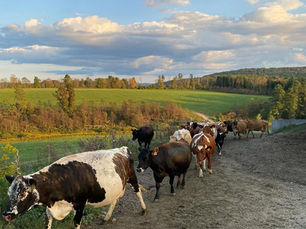A (Brief) History of Regenerative Dairy Farming
- mackenziehartung
- May 20
- 4 min read
Updated: May 20
The picturesque image of dairy farming has always been the same: rolling green pastures dotted with contented cows. We know this isn’t the reality of conventional dairy farms today — but what changed?
The rise of industrial agriculture in the mid-20th century was a catalyst: efficiency and yield became the focus, and production soared. Agriculture had not experienced this level of change since it was shaped around 13,000 years ago. More people had access to more food than ever before, but at the expense of the health of the land, the animals, and ultimately, the food.
Knowing what we know today about the negative impact that industrial agriculture has on our environment, animals, and health, there is a growing desire to turn back to the sustainable wisdom of the past - not just for the sake of the land, but also to make healthier products. Maple Hill is playing an active part in the return to regenerative farming — but what does that mean? And what impact could it have on farming in the future?
Table of Contents:
Our Roots in Regenerative Agriculture
The Consequences of Industrial Agriculture
A Return to Balance
Maple Hill’s Regenerative Dairy Approach
Our Roots in Regenerative Agriculture
While sustainable agriculture aims to maintain the current state of resources, regenerative agriculture goes further, actively working to improve and restore them. It's about leaving the land in better condition than it was found.
Regenerative agriculture isn't a new concept — it's a rediscovery of ancient practices. Indigenous farmers understood the connection between soil health, animal well-being, and environmental balance. These practices focused on working with nature, not against it.
Our shared history shows us what regenerative farming used to look like. Think of the Native American practice of "three sisters" planting, where corn, beans, and squash are grown together, each crop benefiting the others. Or the ancient grazing practices of nomadic groups, who moved their herds strategically to allow grasslands to recover and thrive. Each of these examples shows an understanding of ecological balance that modern industrial agriculture overlooks.
What did regenerative dairy farming look like before industrial agriculture? Pastures were home to diverse grasses and legumes, providing nutrition for free-grazing cows. Herds were smaller and cows naturally fertilized the land, enriching the soil with vital nutrients. Farmers understood the rhythms of nature, rotating crops and giving fields time to rest and regenerate — and these intentional choices were tied to the health of the land and animals.
The Consequences of Industrial Agriculture
In the U.S., the post-World War II era saw a surge in agricultural industrialization. Farms needed to quickly feed a growing population so they started working against nature in an effort to control it. They shifted towards monocultures, using more synthetic fertilizers and pesticides, and concentrated animal feeding operations (CAFOs).
These practices increased yield — and had significant unintended consequences:
Soil Damage: Over-tilling the soil and the lack of cover crops have led to soil erosion, destroying nutrient-rich topsoil and reducing its ability to retain water.
Water Pollution: Runoff from fertilizers and animal waste contaminated waterways and harms animal life.
Greenhouse Gas: Industrial agriculture is a major contributor to greenhouse gas emissions, including nitrous oxide from fertilizers.
Less Biodiversity: Monocultures and habitat destruction have drastically reduced biodiversity in agricultural landscapes.
Animal Welfare Concerns: Farm animals often live in cramped and unsanitary conditions, leading to stress and making them much more likely to become sick.
A Return to Balance
Regenerative agriculture offers an alternative to industrial agriculture. Instead of maximizing profit and yield, it focuses on rebuilding soil health, enhancing biodiversity, and improving the resilience of the farm ecosystem. It’s an approach that recognizes the interconnectedness of all living things, with benefits like:
Pasture Grazing: Cows are allowed to naturally graze on pastures, which improves animal welfare and fertilizes the land naturally.
Soil Health: Practices like no-till farming, cover cropping, and composting are used to improve soil structure, water infiltration, and nutrient cycling.
Biodiversity: Encouraging a diverse range of plant and animal life on the farm creates a stronger ecosystem.
Fewer Chemicals: Regenerative practices minimize the need for synthetic fertilizers, pesticides, and herbicides, reducing environmental pollution and improving food safety.
Carbon Sequestration: Healthy soil and pastures act as a significant carbon sink, drawing down carbon dioxide from the atmosphere and mitigating climate change.
The benefits of regenerative agriculture are backed by research: studies show that regenerative farms have higher levels of organic matter in their soil, improved water holding capacity, and increased biodiversity compared to conventional farms.

Maple Hill’s Regenerative Dairy Approach
Our commitment to regenerative dairy farming goes beyond an organic certification — we’re using the principles of regenerative agriculture to work with a network of family farms and restore the health of the land and improve the lives of our cows.
Our 100% grass-fed and pasture-raised cows graze freely and never eat any grain or corn, the way that they used to eat and behave for thousands of years. This method doesn’t produce more milk, but it does produce better milk, and makes a significant impact toward healthier soil and thriving ecosystems. Our goal isn’t yield and maximum profitability, it’s to embrace sustainable and regenerative practices and produce the best dairy products on grocer’s shelf.
By supporting farms like Maple Hill, you can help to create a food system that is both healthy and sustainable for generations to come. We are working together for a truly regenerative approach to dairy — an approach that benefits the cows, the land, and ultimately, all of us.
Read more about Maple Hill’s commitment to regenerative farming:

Sources:









